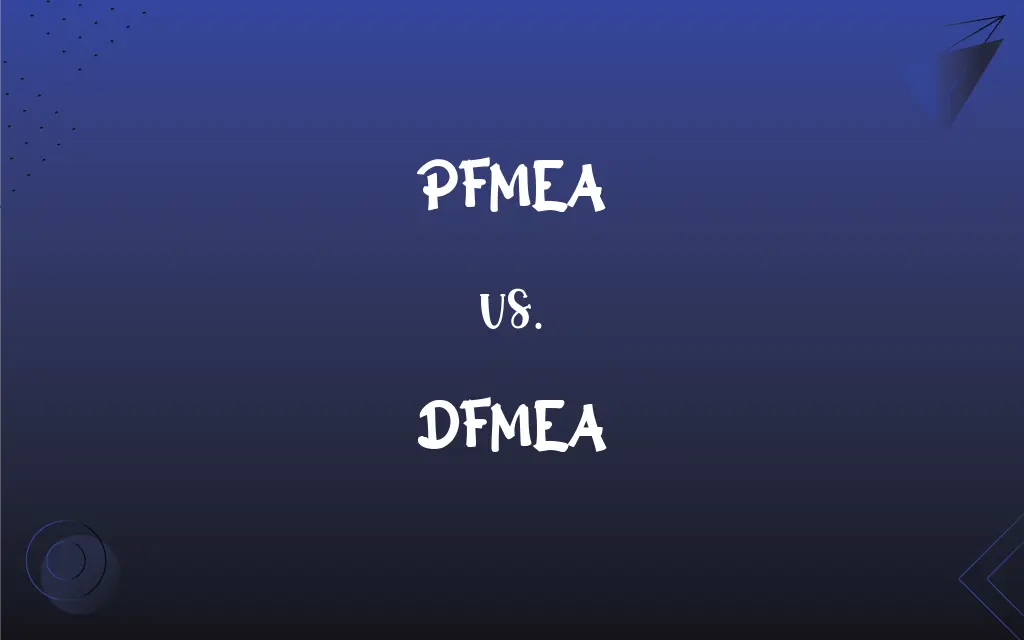PFMEA vs. DFMEA: What's the Difference?
Edited by Harlon Moss || By Janet White || Published on March 14, 2024
PFMEA (Process Failure Mode and Effects Analysis) focuses on manufacturing processes, while DFMEA (Design Failure Mode and Effects Analysis) targets product design flaws.

Key Differences
PFMEA (Process Failure Mode and Effects Analysis) is a systematic approach used to identify potential failures in manufacturing and assembly processes. It aims to evaluate the risk associated with process failures and implement corrective actions to mitigate these risks. DFMEA (Design Failure Mode and Effects Analysis), on the other hand, is a structured methodology applied during the design phase of a product to identify and eliminate known and potential failures, problems, and errors. It helps in understanding the possible ways a product can fail and the effects of such failures.
The primary distinction between PFMEA and DFMEA lies in their application scope. PFMEA is process-oriented, examining steps involved in manufacturing or assembly, identifying potential failures at each step, and evaluating their impact on the final product. DFMEA is design-oriented, focusing on potential design-related failures before the product is manufactured. It analyzes design parameters, materials, geometry, and the interaction between different system components to identify design vulnerabilities.
Both PFMEA and DFMEA are valuable tools in quality management and risk assessment, they serve different purposes. PFMEA is concerned with the reliability and quality of the manufacturing process, while DFMEA addresses potential flaws in product design. Together, they ensure both the design and manufacturing processes are optimized to produce high-quality, reliable products.
Comparison Chart
Focus
Manufacturing and assembly processes
Product design
Objective
Identify and reduce process failures
Identify and reduce design failures
ADVERTISEMENT
Application Phase
Production
Design
Key Considerations
Process steps, material handling, equipment
Design parameters, materials, components
Outcome
Improved process reliability and efficiency
Enhanced product reliability and safety
PFMEA and DFMEA Definitions
PFMEA
Identifies potential process failures.
The PFMEA highlighted critical steps needing additional quality controls.
DFMEA
Focuses on product design and components.
DFMEA analysis resulted in a more robust component interface design.
ADVERTISEMENT
PFMEA
Aids in developing corrective actions for processes.
Based on PFMEA findings, we revised our material handling procedures.
DFMEA
Evaluates potential design failures.
The DFMEA process helped in identifying vulnerabilities in the new product design.
PFMEA
Focuses on production efficiency and safety.
PFMEA was used to enhance worker safety in the plant.
DFMEA
Aims to enhance product reliability.
DFMEA led to design modifications that significantly improved product longevity.
PFMEA
Prioritizes process improvements.
PFMEA guided us to prioritize automation in high-risk areas.
DFMEA
Informs safer product design practices.
DFMEA insights contributed to the development of safer electrical products.
PFMEA
Analyzes risks in manufacturing processes.
Implementing PFMEA reduced the defect rate in assembly line operations.
DFMEA
Prevents design-related defects.
Through DFMEA, we preemptively addressed a critical design flaw.
FAQs
What is the main objective of DFMEA?
The main objective of DFMEA is to ensure product designs are robust, reliable, and free from potential failure modes.
How does PFMEA improve manufacturing processes?
PFMEA improves manufacturing processes by systematically identifying potential failures and implementing corrective actions to reduce or eliminate risks.
Can DFMEA impact product development timelines?
Yes, DFMEA can impact product development timelines by identifying design issues early, potentially leading to design changes that require additional development time.
When should PFMEA be conducted?
PFMEA should be conducted during the planning and implementation phases of manufacturing processes to identify and mitigate potential risks.
What is PFMEA?
PFMEA stands for Process Failure Mode and Effects Analysis, focusing on identifying and mitigating risks in manufacturing processes.
How does DFMEA differ from PFMEA?
DFMEA, or Design Failure Mode and Effects Analysis, focuses on identifying and preventing potential failures in product design, unlike PFMEA, which focuses on manufacturing processes.
Can PFMEA be applied to service industries?
Yes, PFMEA can be applied to service industries by analyzing service delivery processes for potential failures and their effects on service quality.
What role does risk priority number (RPN) play in PFMEA?
In PFMEA, the Risk Priority Number (RPN) helps prioritize process risks based on their severity, occurrence, and detection, guiding risk mitigation efforts.
How do PFMEA and DFMEA contribute to quality assurance?
PFMEA and DFMEA contribute to quality assurance by systematically identifying and mitigating potential failures in processes and designs, ensuring higher quality outputs.
What are the key components of a PFMEA?
Key components of a PFMEA include process function, potential failure modes, potential failure effects, severity, occurrence, and detection rankings.
How is DFMEA integrated into the design process?
DFMEA is integrated into the design process by systematically evaluating design proposals, prototypes, and components to identify and eliminate potential failures.
How does DFMEA contribute to product safety?
DFMEA contributes to product safety by identifying and eliminating design-related failures that could pose safety risks to users.
How often should PFMEA be updated?
PFMEA should be updated whenever there are changes to the manufacturing process, new equipment is introduced, or process failures are identified.
How is severity assessed in DFMEA?
In DFMEA, severity is assessed by evaluating the potential impact of a design failure on the customer, including safety risks and product performance issues.
What industries commonly use PFMEA?
PFMEA is commonly used in manufacturing industries, including automotive, aerospace, electronics, and pharmaceuticals, to ensure process reliability.
Does DFMEA consider user interaction with the product?
Yes, DFMEA considers user interaction with the product, evaluating how design elements can affect user safety and product functionality.
Can PFMEA reduce production costs?
Yes, PFMEA can reduce production costs by identifying and eliminating inefficient or risky processes, leading to more efficient and cost-effective manufacturing.
How does DFMEA assist in regulatory compliance?
DFMEA assists in regulatory compliance by ensuring product designs meet safety and performance standards set by regulatory bodies.
Can PFMEA and DFMEA be used together?
Yes, PFMEA and DFMEA can be used together to provide a comprehensive approach to risk management, addressing both process and design-related risks.
What are the benefits of conducting DFMEA early in the design phase?
Conducting DFMEA early in the design phase allows for the early identification and correction of design flaws, reducing costs and development time.
About Author
Written by
Janet WhiteJanet White has been an esteemed writer and blogger for Difference Wiki. Holding a Master's degree in Science and Medical Journalism from the prestigious Boston University, she has consistently demonstrated her expertise and passion for her field. When she's not immersed in her work, Janet relishes her time exercising, delving into a good book, and cherishing moments with friends and family.
Edited by
Harlon MossHarlon is a seasoned quality moderator and accomplished content writer for Difference Wiki. An alumnus of the prestigious University of California, he earned his degree in Computer Science. Leveraging his academic background, Harlon brings a meticulous and informed perspective to his work, ensuring content accuracy and excellence.































































